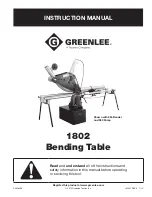
5
PM 728V-T v2 2020-10
Copyright © 2020 Quality Machine Tools, LLC
INITIAL CHECKS
Read Section 3 if unsure about any item in the following
1. Check that no chuck or collet is installed, drawbar re-
moved; no clamps or locks on moving parts.
2. Turn the speed control knob fully counter-clockwise (low-
est speed).
3. Open the blue motor cover. Make sure the belt is set for
low speed (belt running on the larger front pulley.) If not,
re-position the belt, Figure 3-2. Replace the motor cover.
Make sure the spindle is free to turn.
4. Connect 110 Vac power.
5. Be sure the
E-Stop
(Emergency) button has not been
pushed in (it should pop out when twisted firmly clock
-
wise).
6. Press the green
Power
button. The power lamp and the
tach display should light.
7. Select
FWD
spindle direction, then turn the speed knob a
few degrees to the right. Viewed from above, the spindle
should rotate clockwise.
8. Rotate the speed control knob clockwise for a speed of
300 to 400 rpm. Run the spindle at that speed for about
1 minute, then progressively increase the speed to the
maximum (about 1500 rpm).
9. Check the emergency function by pressing the E-Stop
button. This should disable the power circuit, stopping the
spindle. You will hear a series of beeps from the electrical
box once power is disconnected. This is normal.
If #8 doesn’t happen, the E-stop function is defective,
and needs attention - This should stop the machine when
presses
10.
Restore power by twisting the E-Stop button firmly to the
right; this will cause it to pop out. You can now re-start the
machine as shown starting in step 6 above.
11. Re-install the drawbar UNDER the spindle cap, Figure
1-1.
Assembly and cleanup
Unfinished metal surfaces may be protected in shipping by
thick grease and/or paper. Carefully remove these using a
plastic paint scraper, disposable rags and a light-oil such as
WD-40. Coat bright machined surfaces after cleaning with a
rust preventative such as Rustlick. Do not leave them bare, or
rust may stary quickly.
Level the mill using the table surface for reference, shimming
under the tray if necessary. If the mill is on the optional stand,
adjust the leveling feet. Oil the ways and leadscrews (Z-axis
leadscrew excepted, inaccessible).






































